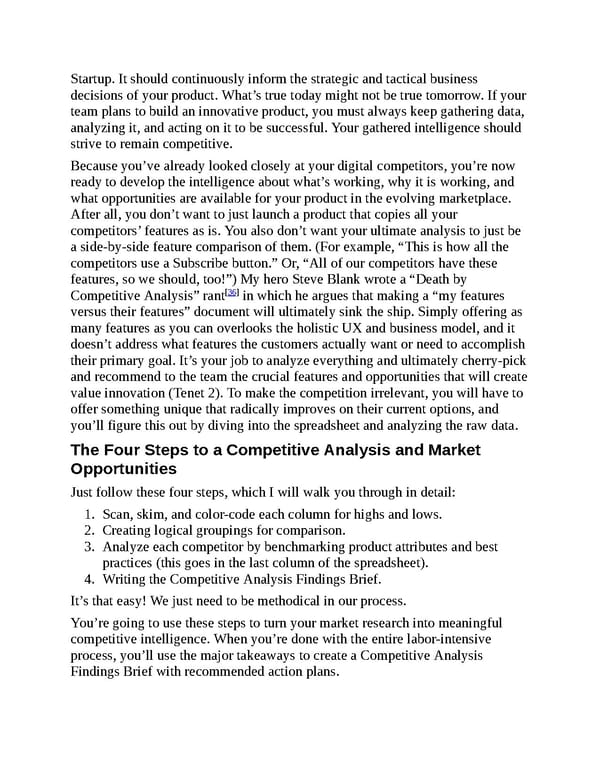Startup. It should continuously inform the strategic and tactical business decisions of your product. What’s true today might not be true tomorrow. If your team plans to build an innovative product, you must always keep gathering data, analyzing it, and acting on it to be successful. Your gathered intelligence should strive to remain competitive. Because you’ve already looked closely at your digital competitors, you’re now ready to develop the intelligence about what’s working, why it is working, and what opportunities are available for your product in the evolving marketplace. After all, you don’t want to just launch a product that copies all your competitors’ features as is. You also don’t want your ultimate analysis to just be a side-by-side feature comparison of them. (For example, “This is how all the competitors use a Subscribe button.” Or, “All of our competitors have these features, so we should, too!”) My hero Steve Blank wrote a “Death by [36] Competitive Analysis” rant in which he argues that making a “my features versus their features” document will ultimately sink the ship. Simply offering as many features as you can overlooks the holistic UX and business model, and it doesn’t address what features the customers actually want or need to accomplish their primary goal. It’s your job to analyze everything and ultimately cherry-pick and recommend to the team the crucial features and opportunities that will create value innovation (Tenet 2). To make the competition irrelevant, you will have to offer something unique that radically improves on their current options, and you’ll figure this out by diving into the spreadsheet and analyzing the raw data. The Four Steps to a Competitive Analysis and Market Opportunities Just follow these four steps, which I will walk you through in detail: 1. Scan, skim, and color-code each column for highs and lows. 2. Creating logical groupings for comparison. 3. Analyze each competitor by benchmarking product attributes and best practices (this goes in the last column of the spreadsheet). 4. Writing the Competitive Analysis Findings Brief. It’s that easy! We just need to be methodical in our process. You’re going to use these steps to turn your market research into meaningful competitive intelligence. When you’re done with the entire labor-intensive process, you’ll use the major takeaways to create a Competitive Analysis Findings Brief with recommended action plans.
 UX Strategy: How to Devise Innovative Digital Products that People Want Page 111 Page 113
UX Strategy: How to Devise Innovative Digital Products that People Want Page 111 Page 113